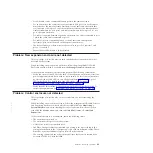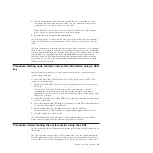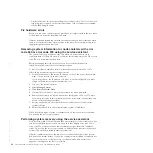
Node errors are reported when there is an error that is detected that affects a
specific node canister.
1.
Use the service assistant to view the current node errors on any node.
2.
If available, use the management GUI to run the recommended action for the
alert.
3.
Follow the fix procedure instructions.
4.
If the recommended action does not provide sufficient information to determine
the service action, review the node error descriptions and service actions. Go to
“Error code range” on page 130.
See the node error descriptions if you cannot access the management GUI or if
the management GUI is not reporting an alert because it cannot connect to the
node. When you cannot connect to the management GUI, follow the procedure
for getting node canister and clustered-system information using the service
assistant. Go to “Procedure: Getting node canister and system information
using the service assistant” on page 48. Start with the node that displays an
error. The home page shows the node errors on the current node in the priority
that you must service them. Start with the node error with the highest priority.
5.
Select a different node in the system to see the node errors on that node.
6.
Attempt to service the node errors in the priority order that they are listed.
7.
Use the error number as an index when reviewing the node error descriptions.
The service actions for each error are listed with the error code. Go to “Error
code range” on page 130.
Procedure: Changing the service IP address of a node canister
This procedure identifies many methods that you can use to change the service IP
address of a node canister.
When you change an IPv4 address, you change the IP address, the subnet, mask,
and gateway. When you change an IPv6 address, you change the IP address,
prefix, and gateway.
Which method to use depends on the status of the system and the other node
canisters in the system. Follow the methods in the order shown until you are
successful in setting the IP address to the required value.
You can set an IPv4 address, an IPv6 address, or both, as the service address of a
node. Enter the required address correctly. If you set the address to 0.0.0.0 or
0000:0000:0000:0000:0000:0000:0000, you disable the access to the port on that
protocol.
Change the service IP address.
v
Use the control enclosure management GUI when the system is operating and
the system is able to connect to the node with the service IP address that you
want to change.
1.
Select
Settings
>
Network
from the navigation.
2.
Select
Service IP Addresses
.
3.
Complete the panel. Be sure to select the correct node to configure.
v
Use the service assistant when you can connect to the service assistant on either
the node canister that you want to configure or on a node canister that can
connect to the node canister that you want to configure:
1.
Make the node canister that you want to configure the current node.
Chapter 6. Resolving a problem
57
|
Summary of Contents for Storwize V7000
Page 1: ...IBM Storwize V7000 Version 6 3 0 Troubleshooting Recovery and Maintenance Guide GC27 2291 02...
Page 6: ...vi Storwize V7000 Troubleshooting Recovery and Maintenance Guide...
Page 8: ...viii Storwize V7000 Troubleshooting Recovery and Maintenance Guide...
Page 10: ...x Storwize V7000 Troubleshooting Recovery and Maintenance Guide...
Page 34: ...18 Storwize V7000 Troubleshooting Recovery and Maintenance Guide...
Page 42: ...26 Storwize V7000 Troubleshooting Recovery and Maintenance Guide...
Page 80: ...64 Storwize V7000 Troubleshooting Recovery and Maintenance Guide...
Page 128: ...112 Storwize V7000 Troubleshooting Recovery and Maintenance Guide...
Page 156: ...140 Storwize V7000 Troubleshooting Recovery and Maintenance Guide...
Page 166: ...150 Storwize V7000 Troubleshooting Recovery and Maintenance Guide...
Page 171: ......
Page 172: ...Printed in USA GC27 2291 02...
















































